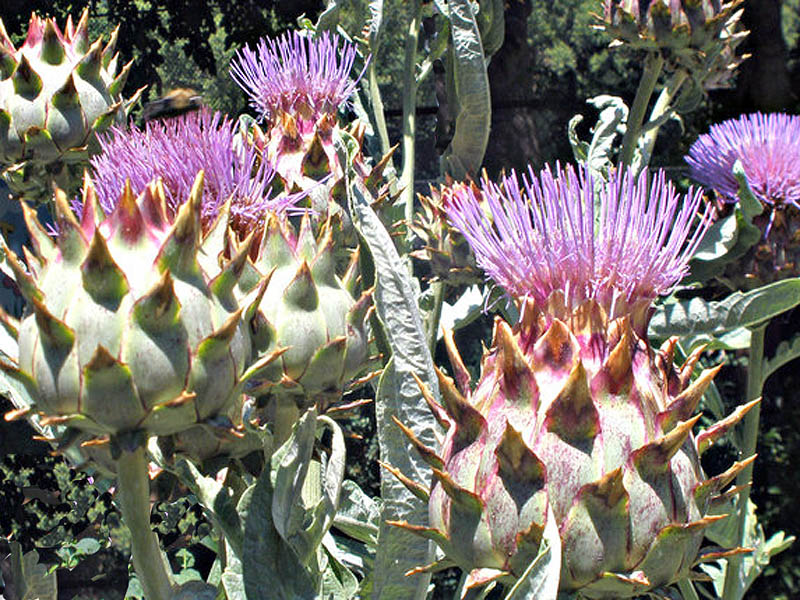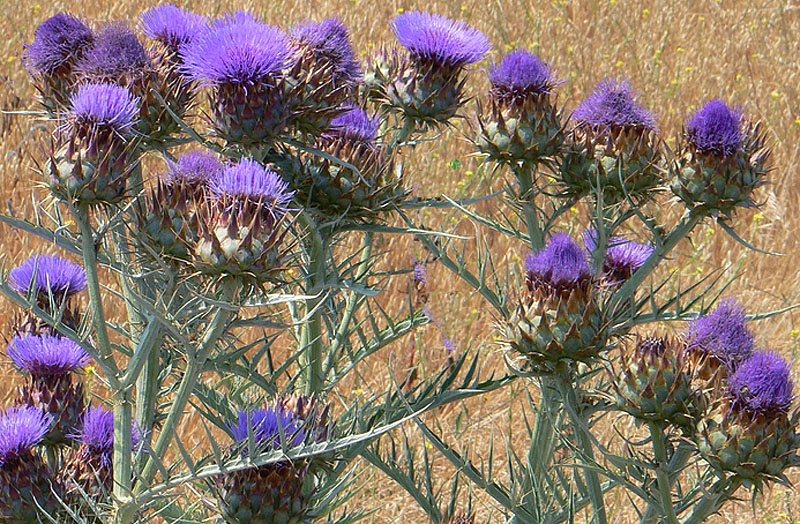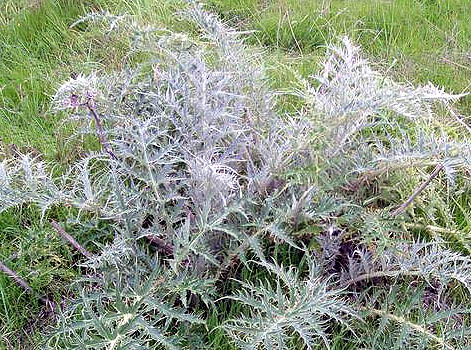Dramatic plant of many uses. Produces large silver blue deep cut leaves that make a wonderful accent to any flower bed although they do need a lot of space. For this reason many people grow them just for the splendid foliage. If you live in a warm zone the plants may flower, sometimes but rarely in the first year so plants need to be in zone 8 maybe 7 for this to happen. When it does it produces large lavender/purple flowers up to 3 inches (7.6cm) cross on prickly stiff branched stems. The are beloved by butterflies bees and humming birds.
Many grow cardoon as a vegetable for its delicious edible stems. They take a little more work as plants need to be blanched before they are harvested but since Cardoon is rarely available for sale its the only way this delectable vegetable can be enjoyed. Easy to grow from seed, grown as an annual for food or decoration in most of the country. Will live as a perennial in warmer zones. Its very prickly so wildlife don't eat it. Needs full sun and good rich soil.
For zones where it can overwinter the second year will produce one or more likely several smaller rosettes that have denser foliage. Each one will produce a single thick stem that in ideal conditions can reach 6 feet (1.8m) in height but in meadowlands is more likely to be just over 3 feet (1m). These stems produce multiple branches from about half way up and each branchlet produces a single large thistle bloom. These can be up to 5 inches (13cm) in diameter are mostly a globular calyx with tough spiny exterior from the top sprouts a large collection of thin needle like purple to lilac 'petals' above a deeper dark maroon base of stamens and stigma. Seeds are fairly large and can be prolific, in some areas of America especially California it is considered an invasive pest.
While there are report of Cardoons being hardy to zone 7 this seems to be mostly a repetition of data rather than fact. The few places that have actually tried to grow them report hardy only to zone 8.
Not all Cardoon seeds are created equal some will produce good strong plants other will produce weaker ones or even albino (white) plants, some wont germinate at all 65% is usual.
So plant seeds in individual 3 inch (7.6cm) pots placing 3-4 seeds in each. After germination evaluate your seedlings are remove any weak or albino ones leaving the strongest seedling to grow. Best germination temperatures are between 70-75 F (21-23C).
Seedlings are slow starters and grow slowly to begin with so need nurture. Grow on indoors or a cool greenhouse where temperatures do not dip below around 50F (10C).
If temperatures are going to drop more than expected plants will need to be covered to protect them. If only a few plants plastic shopping bags can cover each plant, for more plants a plastic sheet held up by wire coat hangers and weighed down with stones works well, any color will do, if using black or transparent ensure it is removed before the sun hit them as this could damage plants. It is not guaranteed that first year seedlings will flower as they often spend the time building a tap root so if you are above zone 7 just grow it for the foliage.
Space plants 18-24 inches (46-61cm) apart in rows 36-48 inches (91-122cm) apart.
Space plants 18-24 inches (46-61cm) apart in rows 36-48 inches (91-122cm) apart.
Which ever method you choose good compost will produce the best plants.
Light. Cardoons need full sun they need at least 6 hours to make the best plants. If you are in zones 8 and more then some light shade mostly from noon sun would be useful as if it gets too hot the cardoons may go dormant and deleaf returning when temperatures reduce in late summer.
Soil. Must be well drained. Adding the compost will aid with this but cardoons do not like wet feet it will rot the roots. Roots tend to go down deep so they need more than a few inches of drainage. They prefer a pH of 6.0 - 7.0. You may need to add some lime if the compost is acidic.
Water. Water in well when transplanting after that only occasionally to ensure even watering which will depend on rainfall. Water the soil around the plant not the leaves. Using a soaker hose running along the base of the plants is the best method, this can then deliver the amount of water required to keep them moist. Don't water or a regular schedule but on demand depending on when it rained.
Feeding. If growing as a vegetable feeding regularly with a high nitrogen fertilizer can help to increase leaf production and reduce likelihood of flowering.
Caution. In areas that are ideal for cardoon growth plants have escaped and become a invasive nuisance plant. This is especially true in some areas of Northern California where plants can grow on steep, hard to reach slopes and become seed sources that can infect crop and rangelands. Do not grow this plant in California unless very strictly controlled.
Now comes the hard part. Harvesting is not as easy as it sounds as Cardoon leaves need to be blanched before they are harvested to ensure they are tender and not stringy plus it is reported to improve the flavor and reduce the bitterness. This is why some gardeners choose to grow their plants in trenches.
First you need to remove all the dead and dying leaves from the base of the plant. Once done it should look like a head of celery.
Next the leaves are gathered together in a bunch and tied up either with one single piece of twine wrapped up in a spiral or in several pieces in sections up the leaf to make a cylindrical shape. Use soft twine or raffia to avoid damaging the leaves. The whole cylinder is then wrapped in burlap and sections of cardboard or pieces of weed barrier. The objective is to prevent light from reaching the cylinder of leaves. Once completed it should be a covered cylinder with a few green leaf sections poking out the top. This will then cause the chlorophyll (green bit) to vanish from the plant and many of the compounds that were stored in the leaves will be removed by the plant. This process takes around 4-6 weeks. Check plants regularly during this period as they are more prone to rotting and disease at this time especially if there is high rainfall.
If you have a series of plants blanch them in a staggered fashion so you always have plants preparing for harvest. Once the plant has been blanched it must be harvested.
If cardoons are grown in a trench plants can be covered with soil rather than wrapped. Once blanching has completed plants are dug up and harvested.
Ribs need to be removed from the leafy section then cut into sections before cooking. Cardoon is only eaten cooked where it tastes very similar to artichoke but with less preparation work (if you don't count the blanching).
Ribs can then be used in multitude of ways. Braising is a common method of cooking but they can also be deep fried, sautéed, slow cooked or added to soups and stews.
Flower buds can also be eaten and prepared in the same manner as traditional artichokes however they are smaller and more fiddly to deal with. Only the base of the bract and the 'heart' of base of the petals is eaten the flavor is reported as milder and more delicate that traditional artichokes
Roots. Can be cooked like parsnips. They are large, fleshy, tender and most agree they have an agreeable flavor.
Bio fuel research is investigating cardoon seeds as a source of oil.









